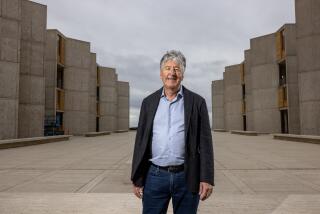Acting Director Named to Top Job at Livermore Lab
- Share via
Acting on the recommendation of University of California President Jack W. Peltason, the UC Board of Regents on Wednesday appointed a new director of the Lawrence Livermore National Laboratory, one of the government’s premier nuclear weapons research centers.
C. Bruce Tarter, 54, an astrophysicist who has served as the lab’s acting director since April, was named to the $186,600-a-year post effective immediately. He replaces John H. Nuckolls, who resigned after an internal review panel found “serious management shortcomings” during his five-year tenure.
Tarter’s appointment comes at a time when the U.S. Department of Energy is striving to make contractors such as the Livermore lab more accountable, tightening management practices and adopting stricter performance standards. Moreover, the facility is still adjusting to the dramatic reduction in funding for nuclear weapons research brought about by the end of the Cold War.
Tarter will be running an institution he knows very well. He joined the lab in 1967--the year he got his Ph.D from Cornell University--and he has held several high-level positions during his 27 years there. He was chosen after a nationwide search that attracted more than 80 applicants.
At a news conference at the UC system headquarters in Oakland, Tarter appeared to address some of the ongoing concerns about the lab, saying, “We have continuing national security responsibilities and will fulfill them and satisfy the sponsors of our work.”
Peltason called Tarter a dynamic leader and praised him for the work he had done as acting director “to begin framing the future of the Livermore laboratory in response to the changing scientific and technical needs of the nation.”
For two generations, the University of California has overseen the laboratories that design, test and ensure the safety of the nation’s nuclear arsenal.
The U.S. Department of Energy pays the UC system $30 million a year to manage Lawrence Livermore, which has 7,300 employees and an annual budget of almost $900 million, as well as Los Alamos National Laboratory in New Mexico and Lawrence Berkeley, which does no classified research.
Eager to make its contractors more accountable, the Energy Department has recently begun requiring more efficient business practices. In one sign of closer scrutiny, the U.S. General Accounting Office has peppered the university and its Livermore facility with a series of stinging audits.
For example, auditors discovered that university managers and Livermore officials could not find more than 10,000 classified documents--including material on nuclear weapons and laser design.
In separate investigations, the auditors discovered that Livermore had diverted millions of dollars earmarked for nuclear waste cleanup to independent research projects.
Times science writer Robert Lee Hotz contributed to this article.
More to Read
Sign up for Essential California
The most important California stories and recommendations in your inbox every morning.
You may occasionally receive promotional content from the Los Angeles Times.













